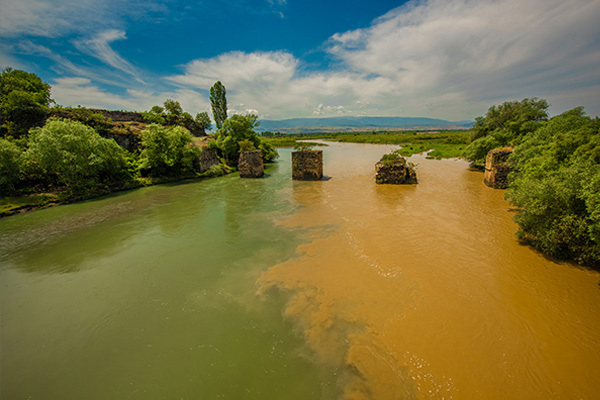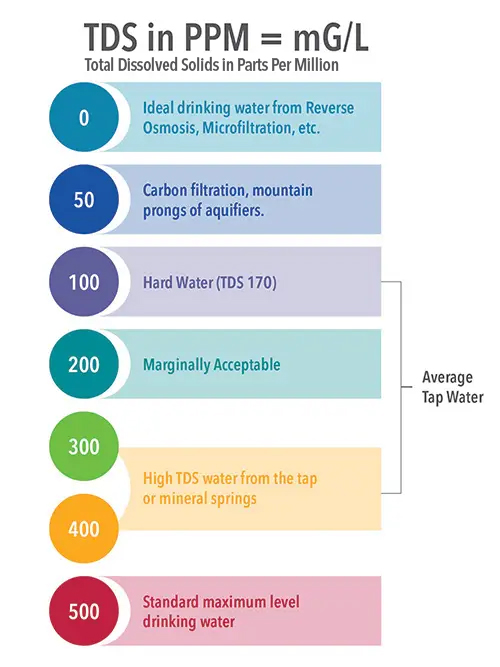Field to Lab: Understanding Turbidity, TDS, and TSS
If you’ve ever seen a river turn murky after heavy rainfall, or noticed particles in your water after utility maintenance, then you probably already know that measuring particles and solids can be critical in assessing water quality profiles.
When it comes to measuring solids for water quality, it’s key to understand that solids exist in a range of physical forms and that different measurement principles can provide different types of information.
Parameters like turbidity, total suspended solids (TSS), and total dissolved solids (TDS) provide information based on the size, distribution, and type of particles present in a solution. In this blog, our YSI team of experts will provide clarity on the difference between each parameter, the measurement data they provide, and offer instrument recommendations for your job!

What is Turbidity?
Turbidity is an optical parameter and is most narrowly defined as, the clarity of a certain medium. Turbidity can be measured in two ways: through nephelometry or turbidimetry. In both methods, light (of a known intensity) passes through a medium and is detected and recorded. Nephelometry measures the degree to which light is scattered, while turbidimetry quantifies the degree to which it is attenuated. Results obtained from these two techniques are now recorded in Nephelometric Turbidity Units (NTU) or Formazin Nephelometric Units (FNU). More specifically, NTU is a unit of measure that is often used to represent turbidity readings captured using white light at a 90-degree detection angle (EPA 180.1 compliant) and FNU is frequently used when readings are captured using an 860 nm light (near IR) with a 90-degree detection angle (ISO 7027 compliant).
YSI’s field turbidity sensors have always followed the ISO 7027 method, so a better representation of the measurements would be to use FNU. Historically, many agencies have collected turbidity data in NTU and now newer YSI instruments like the EXO sondes and the ProDSS provide the option to record data in either of these units. Now, the new Turb® 750 T, a benchtop turbidimeter, is compliant with EPA 180.1 and can record data in NTU YSI is proud to provide you with the flexibility you need, regardless of your technique!
Turbidity is primarily monitored to determine the clarity of water. Highly turbid water is opaque and is often described colloquially as cloudy or murky. This hazy quality of highly turbid water is directly related to the large amount of particles scattered throughout water. In this sense, turbidity and TSS are related, but despite their similarities, it is important not to confuse the two. Turbidity can be used to indicate changes in the TSS concentration of water, but not to provide a particular measurement of those solids. Again, turbidity is purely a measurement of relative clarity.

Even though it is an optical parameter, the usefulness and practicality of turbidity measurement cannot be overstated. Turbidity is one of the easiest and most inexpensive ways to determine the health of a water source. Suspended particles can enter a body of water in a variety of ways; discharges, erosion, runoff, algal blooms, or stirred sediments are just a few of the potential causes of high turbidity. These causes will have an effect on a body of water, and elevated levels of TSS in turbid water can lead to increased water temperatures, decreased dissolved oxygen levels, and reduced levels of photosynthesis - leading to underwater vegetation die-off, further decrease of DO levels, and ecosystem food chain disruption. In addition to this, erosion and runoff can increase the number of contaminants in a body of water, causing detrimental effects in aquatic life and the creation of harmful algal blooms.
What are TDS and TSS?
Unlike turbidity, which is an optical measurement of water clarity, TDS and TSS measurements are both related to the quantity or total mass of particles in water.
TDS refers to the fraction of particles and ions, including metals, minerals, and salts, that can pass through a filter with a 2-micron (micrometer) pore size. TDS measurements represent the total concentration of these dissolved solids in a given volume and are typically expressed in units of grams per liter (g/L), milligrams per liter (mg/L), or parts per million (ppm).

Those solids or particles which cannot pass through a 2-micron filter but remain well suspended in the water sample (i.e., do not settle) are referred to as suspended solids. The particles that make up the total suspended solid concentration of a solution come from countless material types including sediment, silt, sand, algae, bacteria, industrial waste, and pollution to name a few. While TSS measurements do not provide information on the composition of particles, TSS data can be informative in situations where clarity, light availability, or even clogging due to elevated particle content may be a concern.
TSS vs. Turbidity
The TSS concentration of a solution can be determined using sensor technology to measure turbidity levels in the field and calculate TSS based off a correlation to the true TSS value determined via laboratory analysis. Correlation data should be collected for each unique sampling site to ensure representative TSS approximations are reported when using a turbidity sensor for field measurement.
Though turbidity and TSS are frequently monitored water quality parameters, they can also be problematic to instrumentation. For all instruments, heavier particles and sediments can collect on sensor faces and cause erratic or falsely elevated appearance in the dataset. However, there are numerous examples of YSI sondes being partially buried by debris, yet still collecting accurate data. Maintaining sensors and optical surfaces over long-term deployment is critical to accurate data collection. Some YSI sondes, like the EXO2 or EXO2s, are equipped with a mechanical wiper to clean the surface of sensors, prevent drift in measurements, and reduce the trips to the site.
How is Turbidity Measured in the Lab?
Traditional methods to determine the TDS and TSS of a solution are performed in a laboratory setting and involve filtration, evaporation, and gravimetric analysis of the total mass of solids. Laboratory procedures to measure TDS involve passing a known volume of water through a filter of specific pore size and weighing the residue after the filtrate has evaporated. On the other hand, laboratory methods to determine TSS involve drying and weighing the mass of solids captured on the filter during the filtration step. While these gravimetric methods produce highly accurate results, the time it takes to collect samples, deliver them to a laboratory for processing, and receive results can be lengthy, and especially inconvenient when sampling at numerous locations.
How is Turbidity Measured in the Field?
Sensor technology allows users to quickly and accurately determine TDS or TSS concentration of a water sample without having to collect, store, and transport sample bottles to and from the laboratory.
When salts are dissolved in water, they dissociate into positively or negatively charged ions that generate electrical conductance in the solution. These ions are included in the TDS concentration; therefore, an approximate determination of TDS can be reported if the conductivity of a solution is known. For this same reason, TDS measurements are more frequently used in freshwater applications due to the naturally elevated salt content of saltwater systems.
Approximating TDS concentrations from electrical conductivity is a common technique used across multiple measurement systems for both field and laboratory applications. Using instruments equipped with a conductivity sensor, TDS can be determined in the field through simple spot sampling with several YSI portable systems, including the ultimate ProDSS sampling instrument or through long-term monitoring applications using one of YSI’s EXO Sondes. If you are considering one of these systems, you can use our buyer enablement tool to help you figure out which one is right for you! (Learn more, Turbidity Measurements: Tips and Precautions).
Turbidity Measurement Concerns
Turbidity has developed a reputation for providing diverging results over the years, due in large part to the number of various platforms offered on the market. Particle size, shape, distribution throughout the water sample, morphology, and color can have an impact on the accuracy of the turbidity measurement as well. Regardless of the cause, it is true that turbidity measurements are subject to an array of possible interferences. These interferences will lead to either positive or negative bias. Negative bias, or a display of results below their true value, happens most frequently in samples with a NTU value higher than 1, and the margin of error becomes more significant at values even greater than that. Positive turbidity interferences are most likely to be found in samples that have extremely low turbidity values (readings below 0.1 NTU), and therefore are more likely to be found in ultrapure water applications.
How the TURB 750 T Alleviates These Concerns
The new YSI Turb 750 T is equipped with features that will alleviate many of these concerns. One is the Intelligent Reproducibility and Plausibility Check (IRPC), a principle of operation by which the meter takes multiple measurements and removes any outliers automatically. Also, measurement range can be changed on the fly, making quick work of ultrapure water applications. When a turbidity sample is taken back to the lab for measurement, it is likely to be a time-sensitive affair. Particles within the obtained sample will settle rapidly, which leads to a positive or negative bias when reporting results. Fortunately, you can quickly run samples on the YSI Turb 750 T thanks to features such as QuickCAL, AQA (Analytical Quality Assurance) support, and the IRPC procedure. While the Turb 750 T is rugged enough to be used outside, the lab setting allows for easy maintenance of the analyzer and its operational accessories. Not to mention, its compact design naturally lends itself to laboratory applications.
Importance of Standards
Selecting the right calibration standards to use in your application is just as important as selecting the right hardware. Turbidity sensor manufacturers will recommend which standards are approved for successful calibration, and these approved standards are the only ones that should be used. The key point here to remember is not all AMCO standards are prepared or tested in a manner that makes them conducive to be used to calibrate all turbidity sensors. The AMCO turbidity standards used to calibrate YSI turbidity sensors should only be purchased from YSI. Other AMCO standards have not necessarily been tested to YSI’s specifications and it is highly likely the value of the turbidity standard printed on the label of the standard does not reflect what a YSI turbidity sensor will read when placed in that standard. (Learn more, YSI Calibrations Solutions and Buffers Expiration Times).
Turbidity, TDS, and TSS are reliable measurement techniques that play their most critical role in the analysis of water. As the quality of our water continues to be a part of the global conversation, having the right tools to monitor our precious natural resources is of the utmost importance. At YSI, our time-tested instrumentation makes your data collection easy.